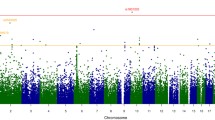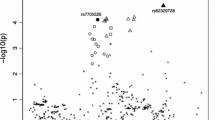Abstract
Purpose
Endometriosis is a gynecological disease influenced by multiple genetic and environmental factors. The aim of the current study was to use SNP-array technology to identify genomic aberrations that may possibly contribute to the development of endometriosis.
Methods
We performed an SNP-array genotyping of pooled DNA samples from both patients (n = 100) and controls (n = 50). Copy number variation (CNV) calling and association analyses were performed using PennCNV software. MLPA and TaqMan Copy-Number assays were used for validation of CNVs discovered.
Results
We detected 49 CNV loci that were present in patients with endometriosis and absent in the control group. After validation procedures, we confirmed six CNV loci in the subtelomeric regions, including 1p36.33, 16p13.3, 19p13.3, and 20p13, representing gains, while 17q25.3 and 20q13.33 showed losses. Among the intrachromosomal regions, our results revealed duplication at 19q13.1 within the FCGBP gene (p = 0.007).
Conclusions
We identified CNVs previously associated with endometriosis, together with six suggestive novel loci possibly involved in this disease. The intergenic locus on chromosome 19q13.1 shows strong association with endometriosis and is under further functional investigation.


Similar content being viewed by others
References
Bulun SE. Endometriosis. N Engl J Med. 2009;360(3):268–79.
Giudice LC, Kao LC. Endometriosis. Lancet. 2004;364(9447):1789–99.
Sasson IE, Taylor HS. Stem cells and the pathogenesis of endometriosis. Ann N Y Acad Sci. 2008;1127:106–15.
de Oliveira R et al. Causes of endometriosis and prevalent infertility in patients undergoing laparoscopy without achieving pregnancy. 2015. Minerva Ginecol.
Bischoff F, Simpson JL. Genetic basis of endometriosis. Ann N Y Acad Sci. 2004;1034:284–99.
Stefansson H et al. Genetic factors contribute to the risk of developing endometriosis. Hum Reprod. 2002;17(3):555–9.
Bouquet De Joliniere J et al. Endometriosis: a new cellular and molecular genetic approach for understanding the pathogenesis and evolutivity. Front Surg. 2014;1:16.
Kobayashi H et al. Understanding the role of epigenomic, genomic and genetic alterations in the development of endometriosis (review). Mol Med Rep. 2014;9(5):1483–505.
Spielman RS, Ewens WJ. The TDT and other family-based tests for linkage disequilibrium and association. Am J Hum Genet. 1996;59(5):983–9.
Montgomery GW et al. The search for genes contributing to endometriosis risk. Hum Reprod Update. 2008;14(5):447–57.
Zhang F et al. Copy number variation in human health, disease, and evolution. Annu Rev Genomics Hum Genet. 2009;10:451–81.
Treloar SA et al. Genomewide linkage study in 1,176 affected sister pair families identifies a significant susceptibility locus for endometriosis on chromosome 10q26. Am J Hum Genet. 2005;77(3):365–76.
Yang W et al. High-resolution array-comparative genomic hybridization profiling reveals 20q13.33 alterations associated with ovarian endometriosis. Gynecol Endocrinol. 2013;29(6):603–7.
Chettier R, Ward K, Albertsen HM. Endometriosis is associated with rare copy number variants. PLoS One. 2014;9(8), e103968.
Welter D et al. The NHGRI GWAS catalog, a curated resource of SNP-trait associations. Nucleic Acids Res. 2014;42(Database issue):D1001–6.
ASRM. Revised American Society for Reproductive Medicine classification of endometriosis: 1996. Fertil Steril. 1997;67(5):817–21.
Lahiri DK, Nurnberger Jr JI. A rapid non-enzymatic method for the preparation of HMW DNA from blood for RFLP studies. Nucleic Acids Res. 1991;19(19):5444.
Docherty SJ et al. Applicability of DNA pools on 500 K SNP microarrays for cost-effective initial screens in genomewide association studies. BMC Genomics. 2007;8:214.
Macgregor S et al. Highly cost-efficient genome-wide association studies using DNA pools and dense SNP arrays. Nucleic Acids Res. 2008;36(6), e35.
Ho DW, Yap MK, Yip SP. UPDG: utilities package for data analysis of pooled DNA GWAS. BMC Genet. 2012;13:1.
Purcell S et al. PLINK: a tool set for whole-genome association and population-based linkage analyses. Am J Hum Genet. 2007;81(3):559–75.
Wang K et al. PennCNV: an integrated hidden Markov model designed for high-resolution copy number variation detection in whole-genome SNP genotyping data. Genome Res. 2007;17(11):1665–74.
Quinlan AR, Hall IM. BEDTools: a flexible suite of utilities for comparing genomic features. Bioinformatics. 2010;26(6):841–2.
Glessner JT, Li J, Hakonarson H. ParseCNV integrative copy number variation association software with quality tracking. Nucleic Acids Res. 2013;41(5), e64.
MacDonald JR et al. The database of genomic variants: a curated collection of structural variation in the human genome. Nucleic Acids Res. 2014;42(Database issue):D986–92.
Kent WJ et al. The human genome browser at UCSC. Genome Res. 2002;12(6):996–1006.
Abraham R et al. A genome-wide association study for late-onset Alzheimer’s disease using DNA pooling. BMC Med Genomics. 2008;1:44.
Manolio TA, Brooks LD, Collins FS. A HapMap harvest of insights into the genetics of common disease. J Clin Invest. 2008;118(5):1590–605.
Meaburn E et al. Genotyping DNA pools on microarrays: tackling the QTL problem of large samples and large numbers of SNPs. BMC Genomics. 2005;6:52.
Lin CH et al. Genome-wide copy number analysis using copy number inferring tool (CNIT) and DNA pooling. Hum Mutat. 2008;29(8):1055–62.
Bosse Y et al. Identification of susceptibility genes for complex diseases using pooling-based genome-wide association scans. Hum Genet. 2009;125(3):305–18.
Kim SY, Kim JH, Chung YJ. Effect of combining multiple CNV defining algorithms on the reliability of CNV calls from SNP genotyping data. Genomics Inform. 2012;10(3):194–9.
Ota VK et al. Candidate genes for schizophrenia in a mixed Brazilian population using pooled DNA. Psychiatry Res. 2013;208(2):201–2.
Albertsen HM et al. Genome-wide association study link novel loci to endometriosis. PLoS One. 2013;8(3), e58257.
Nyholt DR et al. Genome-wide association meta-analysis identifies new endometriosis risk loci. Nat Genet. 2012;44(12):1355–9.
Uno S et al. A genome-wide association study identifies genetic variants in the CDKN2BAS locus associated with endometriosis in Japanese. Nat Genet. 2010;42(8):707–10.
Boyer A et al. WNT4 is required for normal ovarian follicle development and female fertility. FASEB J. 2010;24(8):3010–25.
Vainio S et al. Female development in mammals is regulated by Wnt-4 signalling. Nature. 1999;397(6718):405–9.
Nelson WJ, Nusse R. Convergence of Wnt, beta-catenin, and cadherin pathways. Science. 2004;303(5663):1483–7.
Veiga-Castelli LC et al. Genomic alterations detected by comparative genomic hybridization in ovarian endometriomas. Braz J Med Biol Res. 2010;43(8):799–805.
Meola J et al. Differentially expressed genes in eutopic and ectopic endometrium of women with endometriosis. Fertil Steril. 2010;93(6):1750–73.
Torok I et al. Down-regulation of RpS21, a putative translation initiation factor interacting with P40, produces viable minute imagos and larval lethality with overgrown hematopoietic organs and imaginal discs. Mol Cell Biol. 1999;19(3):2308–21.
Thienpont B et al. Duplications of the critical Rubinstein-Taybi deletion region on chromosome 16p13.3 cause a novel recognisable syndrome. J Med Genet. 2010;47(3):155–61.
Weiss LA et al. A genome-wide linkage and association scan reveals novel loci for autism. Nature. 2009;461(7265):802–8.
Xiong L et al. NT5E and FcGBP as key regulators of TGF-1-induced epithelial-mesenchymal transition (EMT) are associated with tumor progression and survival of patients with gallbladder cancer. Cell Tissue Res. 2014;355(2):365–74.
Gazi MH et al. Downregulation of IgG Fc binding protein (Fc gammaBP) in prostate cancer. Cancer Biol Ther. 2008;7(1):70–5.
O’Donovan N et al. Differential expression of IgG Fc binding protein (FcgammaBP) in human normal thyroid tissue, thyroid adenomas and thyroid carcinomas. J Endocrinol. 2002;174(3):517–24.
Zhou C et al. Screening of genes related to lung cancer caused by smoking with RNA-Seq. Eur Rev Med Pharmacol Sci. 2014;18(1):117–25.
Zhu H et al. Screening for differentially expressed genes between left- and right-sided colon carcinoma by microarray analysis. Oncol Lett. 2013;6(2):353–8.
Choi CH et al. Identification of differentially expressed genes according to chemosensitivity in advanced ovarian serous adenocarcinomas: expression of GRIA2 predicts better survival. Br J Cancer. 2012;107(1):91–9.
Kobayashi K et al. Detection of Fcgamma binding protein antigen in human sera and its relation with autoimmune diseases. Immunol Lett. 2001;79(3):229–35.
Cordeiro Q et al. A review of psychiatric genetics research in the Brazilian population. Rev Bras Psiquiatr. 2009;31(2):154–62.
Giolo SR et al. Brazilian urban population genetic structure reveals a high degree of admixture. Eur J Hum Genet. 2012;20(1):111–6.
Yamaguchi-Kabata Y et al. Japanese population structure, based on SNP genotypes from 7003 individuals compared to other ethnic groups: effects on population-based association studies. Am J Hum Genet. 2008;83(4):445–56.
Author information
Authors and Affiliations
Corresponding author
Ethics declarations
Clinical data and peripheral blood samples were collected following signed informed consent, as approved by the local Research Ethics Committee (CEP FMABC n. 310.094).
Conflict of interest
The authors declare that they have no conflict of interest.
Funding
The work was supported by a grant from Fundação de Amparo a Pesquisa do Estado de Sao Paulo (FAPESP) no. 2011/01363-7. F.M. was supported by FAPESP with two different scholarships, a PhD scholarship no. 2012/22394-8 and a scholarship for internship abroad No. 2014/07136-8, which were realized in collaboration with the Center for Applied Genomics at The Children’s Hospital of Philadelphia.
Additional information
Capsule SNP array genotyping of pooled DNA samples revealed CNVs previously associated with endometriosis and also novel chromosome regions that may contribute to the pathogenesis of this disease.
Rights and permissions
About this article
Cite this article
Mafra, F., Mazzotti, D., Pellegrino, R. et al. Copy number variation analysis reveals additional variants contributing to endometriosis development. J Assist Reprod Genet 34, 117–124 (2017). https://doi.org/10.1007/s10815-016-0822-1
Received:
Accepted:
Published:
Issue Date:
DOI: https://doi.org/10.1007/s10815-016-0822-1




